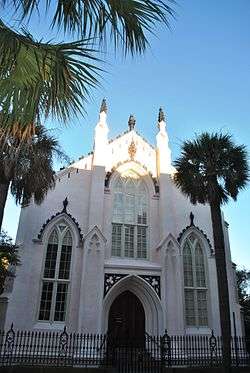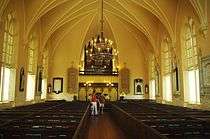Huguenot Church
The Huguenot Church, also called the French Huguenot Church or the French Protestant Church, is a Gothic Revival church located at 136 Church Street in Charleston, South Carolina. Built in 1844 and designed by architect Edward Brickell White, it is the oldest Gothic Revival church in South Carolina, and has been designated a National Historic Landmark and listed on the National Register of Historic Places.[2][3] The congregation it serves traces its origins to the 1680s, and is the only independent Huguenot church in the United States.[4]
Huguenot Church | |
 Huguenot Church | |
  | |
| Location | 136 Church St., Charleston, South Carolina |
|---|---|
| Coordinates | 32.7782°N 79.9291°W |
| Built | 1844, consecrated 1845 |
| Architect | E. B. White (architect) |
| Architectural style | Gothic Revival church |
| NRHP reference No. | 73001687 |
| Significant dates | |
| Added to NRHP | November 7, 1973[1] |
| Designated NHL | November 7, 1973[2] |
As Protestants in predominantly-Catholic France, Huguenots faced persecution throughout the 16th and 17th centuries. Following the Revocation of the Edict of Nantes in 1685, many Huguenots fled France for various parts of the world, including Charleston. The early congregation of Charleston's Huguenot Church included many of these refugees, and their descendants continued to play a role in the church's affairs for many decades.[5] The church was originally affiliated with the Calvinist Reformed Church of France, and its doctrine still retains elements of Calvinist doctrine. The church's services still follow 18th century French liturgy, but are conducted in English.[4]
The church is located in the area of Charleston known as the French Quarter, which was given this name in 1973 as part of preservation efforts. It recognizes that the area had a historically high concentration of French merchants.[6] Peter Manigault, once the wealthiest man in the British North American colonies, is buried in the church cemetery.[7][8]
History
The Huguenots, who were French Calvinists who faced suppression in France, began to settle in other areas in the sixteenth century, founding such failed colonies as Fort Caroline in Florida and Charlesfort in modern South Carolina, as well as settling in established areas, such as South Africa, Britain, and existing colonies such as New Netherlands and Virginia. In 1598, King Henry IV of France issued the Edict of Nantes, granting certain rights and protections to the Huguenots. This edict was revoked by Louis XIV in 1685, prompting an exodus of Huguenots from France.[6]
A group of 45 Huguenots arrived in Charleston in April 1680, having been sent to the colony by the English King Charles II to work as artisans, and began holding sporadic services the following year.[5] The Reverend Phillip Trouillard is believed to have conducted the first service.[5] In 1687, Elias Prioleau became the church's first regular pastor. Prioleau had been pastor of a church in the French town of Pons before his church was torn down in 1685.[9] Prioleau remained pastor of the Charleston Huguenot Church until his death in 1699.[9]
Families associated with the church in its early decades included the Gourdin, Ravenel, Porcher, de Saussure, Huger, Mazyck, Lamar and Lanier families, though the church's early years have been difficult to document due to the loss of its early records in a fire in 1740. Families associated with the church in later years included the Bacot, de la Plaine, Maury, Gaillard, Meserole, Macon, Gabeau, Cazenove, L'Hommedieu, L'Espenard, Serre, Marquand, Bavard, Boudouin, Marion, Laurens, Boudinot, Gibert, Robert, and Fontaine families.[9] Huguenots continued to migrate to Carolina throughout the first half of the 18th century, though most of their congregations were gradually absorbed into the Episcopal Church.[5]
The first Huguenot Church, located at the site of the present church, was blown up by city authorities in an effort to stop a spreading fire. It was replaced by a simple brick church in 1800. This building was torn down in 1844 to make way for the present church, which was completed the following year.[5] This third church sustained damage during the Civil War and the Charleston Earthquake of 1886, and was restored with funds from Huguenot descendant Charles Lanier of New York.[5] The church is surrounded by a graveyard where many Huguenots are buried.
Due to a decline in membership in the early 19th century, the church began translating its French liturgy into English in 1828. With the new English liturgy, an elaborate new building, and charismatic 19th century pastors such as Charles Howard and Charles Vedder, church membership and attendance increased.[9]
By 1912, membership had again declined,[9] and for most of the 20th century, the church was not used for regular religious services. The local community of Huguenot descendants did occasionally open it for weddings, organ recitals, and some occasional services organized by the Huguenot Society of South Carolina. Today's congregation dates from 1983.
Design and construction

The present church was designed by Edward Brickell White, a local architect who had also designed a number of Greek and Roman buildings in the area, most notably Market Hall, the steeple of St. Philip's Episcopal Church, and the St. Matthew's German Evangelical Lutheran Church. The church was built by local contractor Ephraim Curtis.[5]
The church is a stuccoed brick structure, three bays wide and six bays long, with each bay divided by narrow buttresses topped by elaborate pinnacles. The three front windows are topped with cast-iron crockets, and a battlement parapet surrounds the top of the church. The interior consists of walls with plaster ribbed grained vaulting, with marble tablets etched with names of Huguenot families.[5][10]
The church's organ, purchased in 1845, is a unique tracker organ designed by New York organ maker Henry Erben (1801–1883). The "tracker" connects the keys and pipe valves, and responds to the organist faster than modern mechanisms. The organ's tone is similar to organs used during the Baroque period.[4]
Current use
The church now holds regular services, which are in English, although since 1950 an annual service has been conducted in French to celebrate the spring. The congregation still teaches Calvinist doctrine, and its liturgical services are derived from those developed by Neufchâtel and Vallangin, from 1737 and 1772, respectively. The church is governed by a board of directors and board of elders.[4]
See also
References
- "National Register Information System". National Register of Historic Places. National Park Service. January 23, 2007.
- "Huguenot Church". National Historic Landmark summary listing. National Park Service. Archived from the original on 2011-06-06. Retrieved 2008-03-08.
- Tray Stephenson and Bernard Kearse (April 20, 1973). "National Register of Historic Places Inventory-Nomination: The Huguenot Church" (pdf). National Park Service. Cite journal requires
|journal=(help) and Accompanying one photo, exterior, undated (32 KB) - "A Short History of The Huguenot Church," French Protestant (Huguenot) Church website, 2012. Retrieved: 22 August 2012.
- Preservation Society of Charleston, Mary Moore Jacoby (ed.), The Churches of Charleston and the Lowcountry (Columbia, S.C.: University of South Carolina Press, 1994), pp. 10-11.
- French Quarter, Charleston County Public Library website, 2012. Retrieved: 22 August 2012.
- Laurens, Henry (1981). The Papers of Henry Laurens. 9. Columbia, SC: University of South Carolina Press. p. 151. ISBN 978-0-87249-399-5.
- Huguenot Church at Find a Grave
- The French Protestant Church in the City of Charleston (Charleston, S.C.: Walker, Evans and Cogswell, 1912), pp. 3-10.
- "Huguenot Church, Charleston County (136 Church St., Charleston)". National Register Properties in South Carolina listing. South Carolina Department of Archives and History. Retrieved 2008-03-28.
External links
| Wikimedia Commons has media related to Huguenot Church (Charleston, South Carolina). |
- French Protestant (Huguenot) Church, Charleston, SC Official Website
- French Protestant Huguenot Church Cemetery, Charleston, SC, USA at Find A Grave.
- French Huguenot Church, Charleston, SC from the National Park Service website
- Huguenot Church, Charleston County (136 Church St., Charleston), at South Carolina Department of Archives and History
- Historic American Buildings Survey for the French Protestant Huguenot Church, 136 Church Street, Charleston, Charleston County, SC
- Psalm 25 "A toi, mon Dieu, mon cœur monte" from the Genevan Psalter performed at an event at the cathedral in Noyon, France marking the 500th anniversary of John Calvin's birth in 2009. The music has been credited with little documentation to both Claude Goudimel and Louis Bourgeois. Only three of the ten verses of the original are performed here. This is the type of music most certainly used during the early days of this congregation's history. YouTube video (3:06)
- Geneefs Psalter YouTube Playlist of performances of works found in the Genevan Psalter. Contains 183 videos; 10 hours in length.
- 140 Church Street - Hugenot Church
Texts
- Early Prayer Books of America: Being a Descriptive Account of Prayer Books Published in the United States, Mexico and Canada by Rev. John Wright, D.D. St Paul, MN: Privately Printed, 1898. Pages 188 to 210 are entitled "The Prayer Book of the French Protestants, Charleston, South Carolina." (597 pdfs)
- The French Protestant Church in the City of Charleston: "the Huguenot Church" A Brief History of the Church and Two Address Delivered on the 225th Anniversary of the Founding of the Church, April 14, 1912. (1912, 47 pdfs)
- The French Protestant (Huguenot) Church in the City of Charleston, South Carolina. Includes history, text of memorial tablets, and the rules adopted in 1869. (1898, 40 pdfs)
- Preamble and Rules for the Government of the French Protestant Church of Charleston: Adopted at Meetings of the Corporation Held on the 12th and the 19th of November, 1843. (1845, 26 pdfs)
Liturgical Books (in Chronological Order)
- The Liturgy of the French Protestant Church, Translated from the Editions of 1737 and 1772, Published at Neufchatel, with Additional Prayers, Carefully Selected, and Some Alterations: Arranged for the Use of the Congregation in the City of Charleston, S. C. Charleston, SC: James S. Burgess, 1835. (205 pdfs)
- The Liturgy, or Forms of Divine Service, of the French Protestant Church, of Charleston, S. C., Translated from the Liturgy of the Churches of Neufchatel and Vallangin: editions of 1737 and 1772. With Some Additional Prayers, Carefully Selected. The Whole Adapted to Public Worship in the United States of America. Third edition. New York, NY: Anson D. F. Randolph & Company, 1853. 228 pp. Google Books and the Internet Archive. Available also from Making of America Books as a DLXS file or in hardcover. Links to the French liturgical books cited here and to John Quick's Synodicon in Gallia Reformata will be found on the "Texts" subheading to the External Links section of the Wikipedia Huguenot article.
- The Liturgy of the French Protestant Church, Translated from the Editions of 1737 and 1772, Published at Neufchatel, with Additional Prayers Carefully Selected, and Some Alterations. Arranged for the Use of the Congregation in the City of Charleston, S. C. New York, NY: Charles M. Cornwell, Steam Printer, 1869. (186 pdfs)


